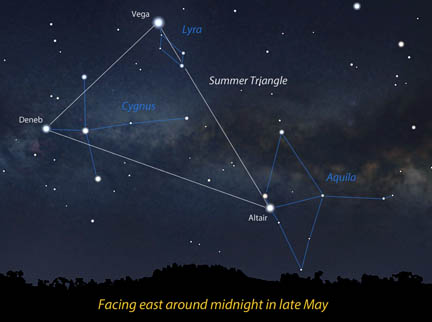
Stellarium
Friday, May 24
• The big Summer Triangle comes into view in the east these evenings, one star after another. First in view as night descends is Vega, the brightest star in the east-northeastern sky. Lower left of it (by two or three fists at arm's length) is Deneb. Farther to Vega's lower right is Altair, which rises above the horizon not long after dark.
Saturday, May 25
• Have you ever seen Alpha Centauri? At declination –61° it's permanently out of sight if you live north of latitude 29°. But if you're at the latitude of San Antonio, Orlando, or points south, Alpha Cen skims just above your southern true horizon for a little while late these evenings.
When does this happen? Just about when Alpha Librae, the lower-right of Libra's two brightest stars, is due south over your landscape. At that time, drop your gaze down from there!
Sunday, May 26
• Bright Arcturus, magnitude 0 and pale yellow-orange, shines high overhead toward the south these evenings. The kite shape of Bootes, its constellation, extends upper left from it. The kite is narrow, slightly bent, and 23° long: about two fists at arm's length.
Just east (left) of the Bootes kite is the semicircle of Corona Borealis, the pretty but mostly dim Northern Crown. Its brightest star, Alphecca, is the gem mounted on its front.
• Last-quarter Moon (exact at 12:34 p.m. EDT). Tonight the Moon rises around 2 a.m. daylight-saving time in dim Aquarius. It's still fairly low in the southeast just as dawn begins on Monday the 27th. At that time, use binoculars to try to catch Fomalhaut (yes, the "Autumn Star"!) barely risen far down below the Moon. The farther south you are, the better your chance of catching Fomalhaut so early in the year.
Monday, May 27
• This is the time of year when Leo the Lion walks downward toward the west, on his way to departing into the sunset in early summer. Right after dark, spot the brightest star fairly high in the west-southwest. That's Regulus, his forefoot.
Tuesday, May 28
• Ceres, the largest asteroid, is at opposition and magnitude 7.0 this week. It's high in the south by midnight: in Ophiuchus 9° north of Antares. See the article and finder chart in the May Sky & Telescope, page 48.
Wednesday, May 29
• Bright Capella sets low in the northwest fairly soon after dark these evenings (depending on your latitude). That leaves Vega and Arcturus as the brightest stars in the evening sky. Vega shines in the east-northeast. Arcturus is very high toward the south.
A third of the way from Arcturus to Vega look for semicircular Corona Borealis, with 2nd-magnitude Alphecca as its one moderately bright star.
Two thirds of the way from Arcturus to Vega is the dim Keystone of Hercules, now lying almost level. Use binoculars or a telescope to examine its top edge. A third of the way from the edge's left end to right end is 6th-magnitude M13, one of Hercules's two great globular star clusters.
Thursday, May 30
• A gigantic asterism you may not know is the Diamond of Virgo, some 50° tall and extending over five constellations. It currently stands upright in the south after the stars come out.
Start with Spica, its bottom. Upper left from Spica is bright Arcturus. Almost as far upper right from Arcturus (as you face south) is fainter Cor Caroli, 3rd magnitude, almost overhead. The same distance lower right from there is Denebola, the 2nd-magnitude tail-tip of Leo. And then back to Spica.
The bottom three of these stars, the brightest, form a nearly perfect equilateral triangle. Maybe we should call this the "Spring Triangle" to parallel those of summer and winter?
In you have a dark sky or binoculars, look halfway from Cor Caroli to Denebola for the very large, sparse Coma Berenices star cluster. It spans some 4°, about the size of a ping-pong ball held at arm's length.
See Fred Schaaf's tour of this area in the May Sky & Telescope, page 45.
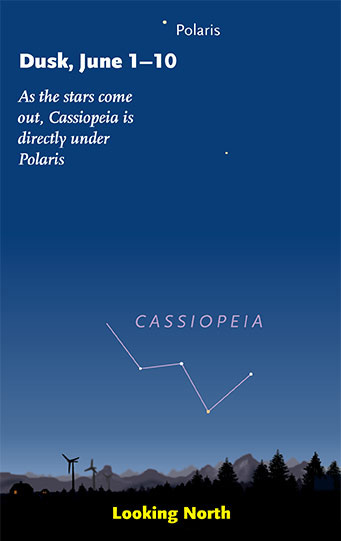
Friday, May 31
• The Dipper Twist. Constellations seem to twist around fast when they pass your zenith — if you're comparing them to the direction "down," i.e. away from the zenith. Just a week and a half ago, the Big Dipper floated horizontally in late twilight an hour after sunset (as seen from 40° N latitude). Now it's angled diagonally at that time. In another week and a half it will be hanging straight down by its handle!
Saturday, June 1
• "Cassiopeia" usually means "Cold!" Late fall and winter are when this landmark constellation, almost opposite the Big Dipper across Polaris, stands high overhead in the evening (seen from mid-northern latitudes). But even on warm June evenings, it still lurks low. As twilight fades out, look for it down near the north horizon: a wide, upright W, as shown here.
The farther north you are the higher it'll appear. But even as far south as San Diego and Atlanta it's completely above the true horizon.
________________________
Want to become a better astronomer? Learn your way around the constellations. They're the key to locating everything fainter and deeper to hunt with binoculars or a telescope.
This is an outdoor nature hobby. For an easy-to-use constellation guide covering the whole evening sky, use the big monthly map in the center of each issue of Sky & Telescope, the essential guide to astronomy.

Once you get a telescope, to put it to good use you'll need a detailed, large-scale sky atlas (set of charts). The basic standard is the Pocket Sky Atlas (in either the original or Jumbo Edition), which shows stars to magnitude 7.6.
Next up is the larger and deeper Sky Atlas 2000.0, plotting stars to magnitude 8.5; nearly three times as many. The next up, once you know your way around, are the even larger Interstellarum atlas (stars to magnitude 9.5) and Uranometria 2000.0 (stars to magnitude 9.75). And read how to use sky charts with a telescope.
You'll also want a good deep-sky guidebook, such as Sue French's Deep-Sky Wonders collection (which includes its own charts), Sky Atlas 2000.0 Companion by Strong and Sinnott, or the bigger Night Sky Observer's Guide by Kepple and Sanner.
Can a computerized telescope replace charts? Not for beginners, I don't think, and not on mounts and tripods that are less than top-quality mechanically (meaning heavy and expensive). And as Terence Dickinson and Alan Dyer say in their Backyard Astronomer's Guide, "A full appreciation of the universe cannot come without developing the skills to find things in the sky and understanding how the sky works. This knowledge comes only by spending time under the stars with star maps in hand."
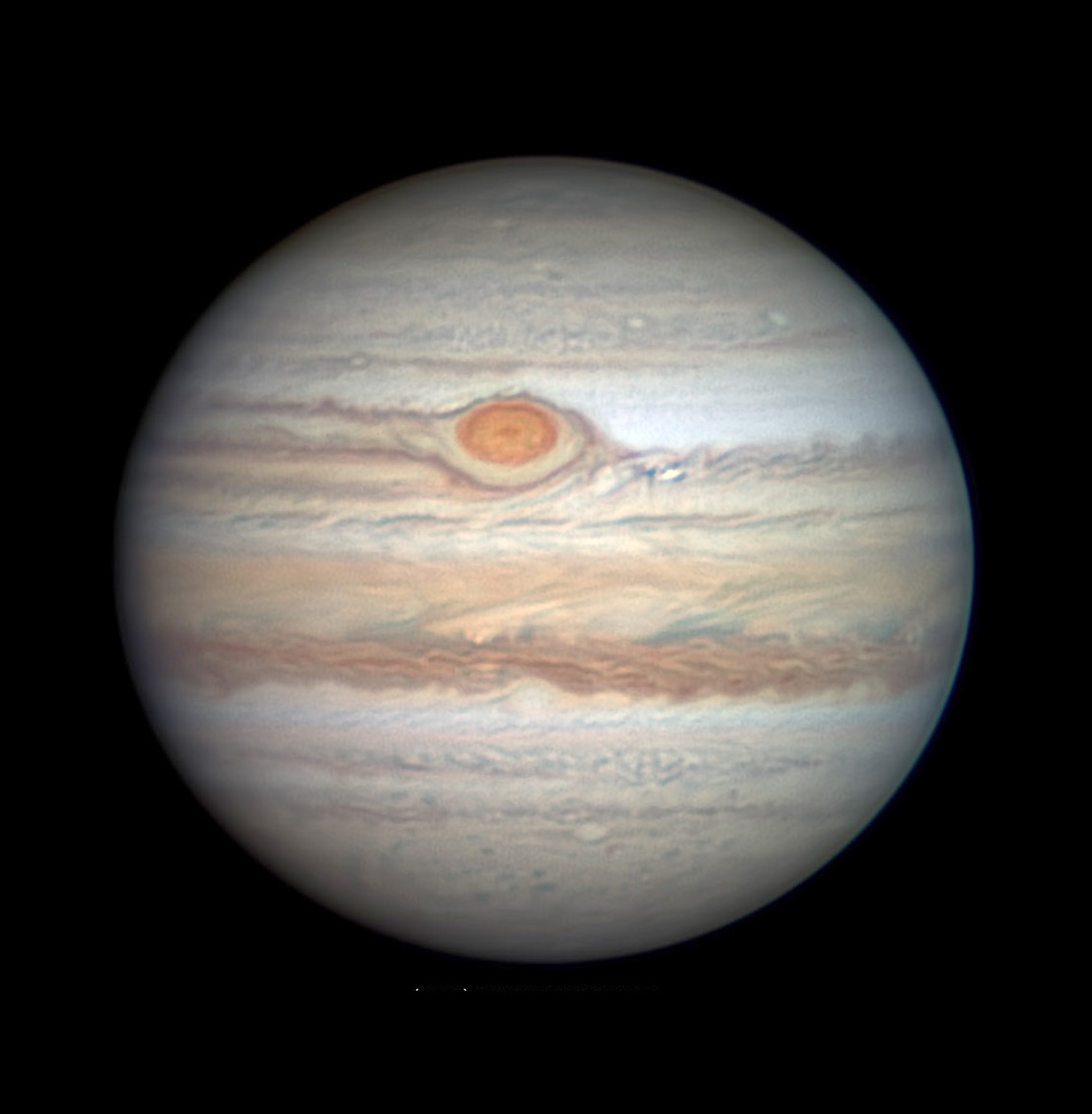
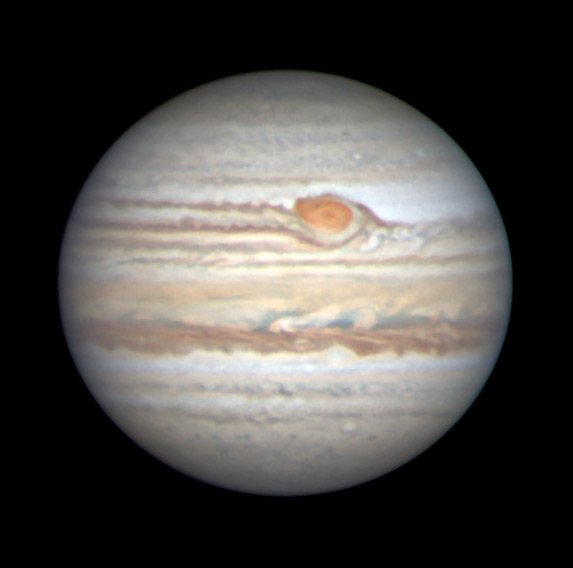
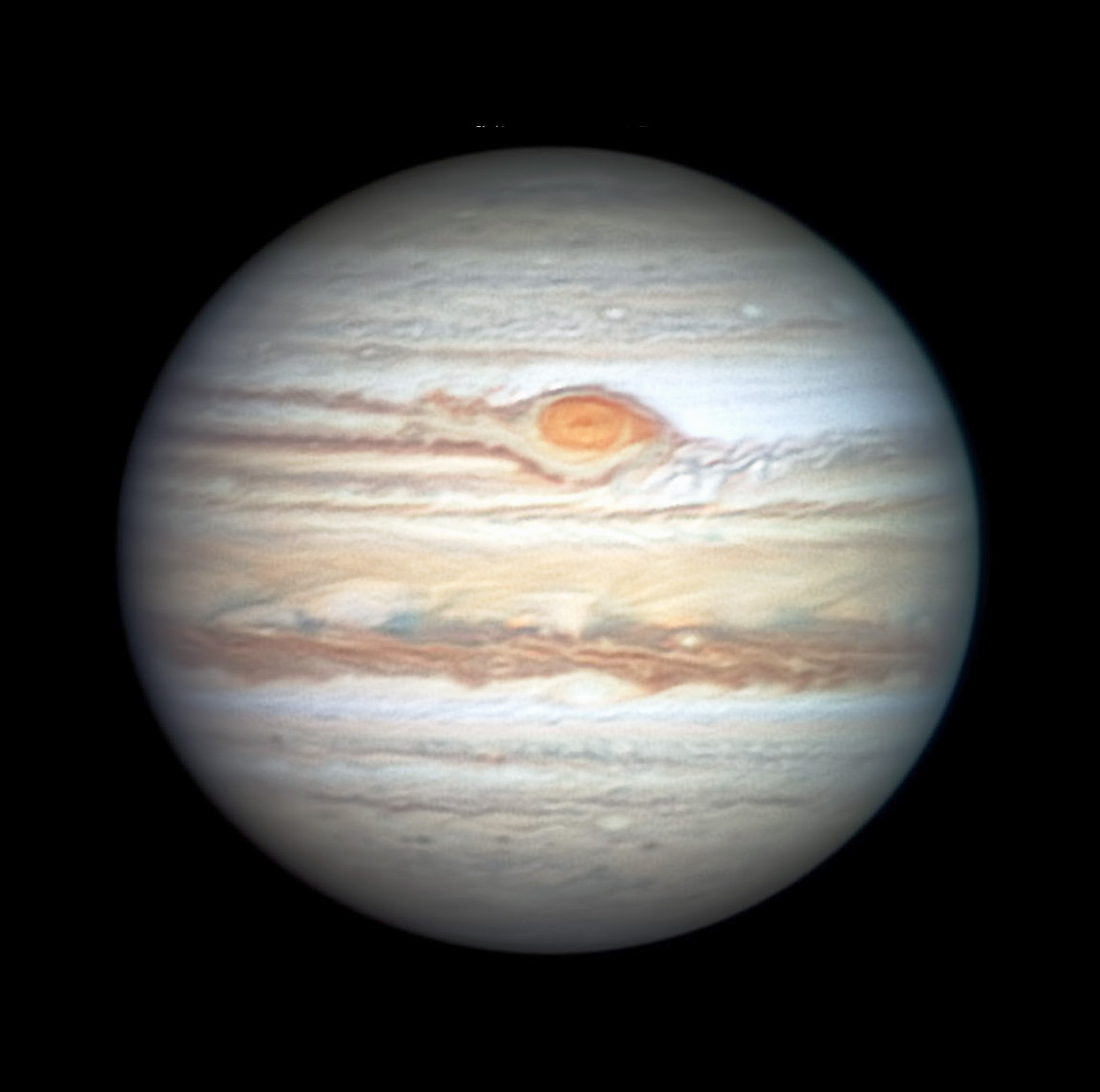
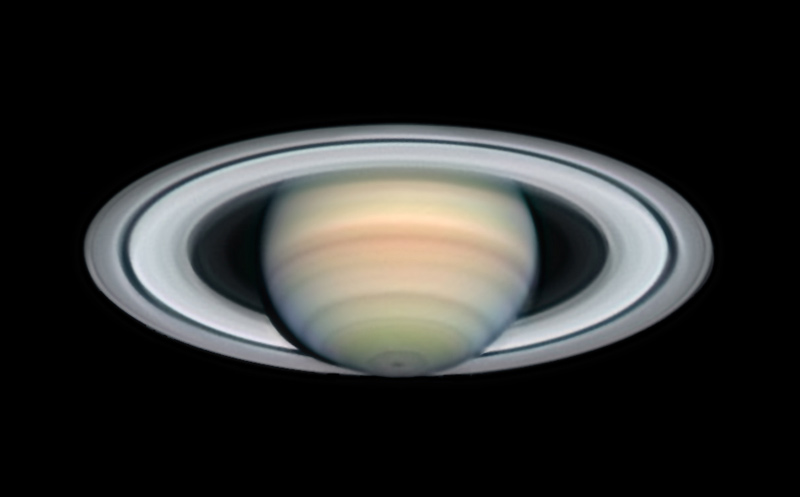
Mercury is hidden deep in the sunset. . . for now.
Venus (magnitude –3.8) is buried very low in bright dawn. About 15 or 20 minutes before sunrise, scan for it with binoculars a little above the east to east-northeast horizon.
Mars (magnitude +1.7) is low in the west during and shortly after dusk, near the feet of Gemini. Look for it far below or lower right of Castor and Pollux.
Don't confuse Mars with similarly faint Gamma Geminorum (Alhena) off to its left, much brighter Procyon farther to the left, and bright Capella about equally far to Mars's right.
Jupiter (magnitude –2.6, in the eastern leg of Ophiuchus) rises in the southeast in late twilight. It shines highest in the south around 2 a.m., with orange Antares about 12° to its lower right.
In a telescope Jupiter is nearly 46 arcseconds wide as it approaches opposition June 10th. Big changes are happening in and around Jupiter's Great Red Spot. the South Equatorial Belt appears to be pulling material away from it; see Jupiter’s Great Red Spot Unfurls.
Saturn (magnitude +0.3, in Sagittarius) rises around 11 or midnight. In the hours before dawn, it's the steady, pale yellowish "star" about 30° (three fists at arm's length) left of Jupiter.
Uranus is still hidden in the glow of dawn.
Neptune (magnitude 7.9) is low in the east-southeast before dawn begins.
______________________
All descriptions that relate to your horizon — including the words up, down, right, and left — are written for the world's mid-northern latitudes. Descriptions that also depend on longitude (mainly Moon positions) are for North America.
Eastern Daylight Time (EDT) is Universal Time (UT, UTC, GMT, or Z time) minus 4 hours.
______________________
Audio sky tour. Out under the evening sky with your earbuds in place, listen to Kelly Beatty's monthly podcast tour of the heavens above. It's free.
______________________
“This adventure is made possible by generations of searchers strictly adhering to a simple set of rules. Test ideas by experiments and observations. Build on those ideas that pass the test. Reject the ones that fail. Follow the evidence wherever it leads, and question everything. Accept these terms, and the cosmos is yours.”
— Neil deGrasse Tyson, 2014
______________________
 0
0








Comments
You must be logged in to post a comment.